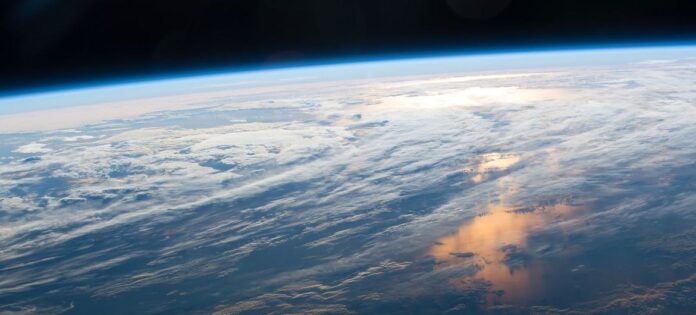While the majority of climate news and developments paint a grim picture, an announcement from the United Nations yesterday proves that human action in the form of adaptation methods and policy can result in positive change.
According to a UN-backed panel of experts, the Earth’s ozone layer is on track to recover within four decades. However, the group also warned of the unintended impacts on the ozone layer of new technologies such as geoengineering.
The ozone hole happens when the protective ozone layer in the stratosphere above the South Pole begins to thin every September. Chlorine and bromine derived from human-produced compounds are released from reactions on high-altitude polar clouds. The chemical reactions then begin to deplete the ozone layer as the sun rises at the end of the winter in the Southern Hemisphere, with the strongest depletion occurring above Antarctica. When the ozone layer is depleted, radiation can reach the surface of Earth – causing potential harm to humans and other living things. For example, ultraviolet rays can damage DNA and cause sunburn, increasing the long-term risk of problems such as skin cancer.
The discovery of a hole in the ozone layer was first announced by three scientists from the British Antarctic Survey, in May 1985. Two years later, the Montreal Protocol was signed and remains a landmark multilateral environmental agreement that regulates the consumption and production of nearly 100 man-made chemicals, or ‘ozone-depleting substances’ (ODS). In the latest report on the progress of the Montreal Protocol, the panel confirmed the phase-out of nearly 99 per cent of banned ODS.
The report explains how the overall phase-down has led to the notable recovery of the protective ozone layer in the upper stratosphere and decreased human exposure to harmful rays from the sun.
“The impact the Montreal Protocol has had on climate change mitigation cannot be overstressed,” said Meg Seki, Executive Secretary of the UN Environment Program’s (UNEP) Ozone Secretariat. “Over the last 35 years, the Protocol has become a true champion for the environment. The assessments and reviews undertaken by the Scientific Assessment Panel remain a vital component of the work of the Protocol that helps inform policy and decision-makers.”
According to the panel’s report, if current policies remain in place, the layer is expected to recover to 1980 values by 2040. Over the Antarctic, this recovery is expected by around 2066, and by 2045 over the Arctic. Variations in the size of the Antarctic ozone hole, particularly between 2019 and 2021, were driven largely by meteorological conditions. Nevertheless, the Antarctic ozone breach has been slowly improving in area and depth, since the year 2000.
The Montreal Protocol has already benefited efforts to mitigate climate change, helping avoid global warming by an estimated 0.5°C. The report reaffirms the positive impact that the treaty has had on the climate.
In 2016 an additional agreement to the Montreal Protocol, known as the Kigali Amendment required a phase-down of the production and consumption of some hydrofluorocarbons (HFCs). HFCs do not directly deplete ozone but are powerful gases which contribute to global warming and accelerated climate change. The panel said that it’s estimated the amendment will avoid another 0.3–0.5°C of warming by 2100.
“Ozone action sets a precedent for climate action. Our success in phasing out ozone-eating chemicals shows us what can and must be done – as a matter of urgency – to transition away from fossil fuels, reduce greenhouse gases and so limit temperature increase,” said World Meteorological Organization Secretary-General Petteri Taalas.
The report does not only bring good news however, and the panel cautioned against the use of a potential method to reduce climate warming by increasing sunlight reflection.
For the first time, they examined the potential effects on the ozone arising from the intentional addition of aerosols into the stratosphere, known as a stratospheric aerosol injection (SAI). SAI has the potential to limit the rise in global surface temperatures by increasing the concentrations of particles in the stratosphere. These particles reflect a fraction of sunlight back to space, in a process similar to that evident after large volcanic eruptions. But the panel warned that an “unintended consequence” of SAI was that it “could also affect stratospheric temperatures, circulation and ozone production and destruction rates and transport.”
The panel’s report follows findings from the U.S. National Oceanic and Atmospheric Administration (NOAA) and National Aeronautics and Space Administration (NASA) in October 2022 that the hole over Antarctica had an average area of 8.91 million square miles (23.2 million square kilometers), which was slightly smaller than the extent of 8.99 million square miles (23.3 million square kilometers) reached in 2021, and well below the average seen in 2006 when the hole size peaked.
“Over time, steady progress is being made and the hole is getting smaller,” said Paul Newman, chief scientist for Earth Sciences at NASA’s Goddard Space Flight Center. “We see some wavering as weather changes and other factors make the numbers wiggle slightly from day to day and week to week. But overall, we see it decreasing through the last two decades. Eliminating ozone-depleting substances through the Montreal Protocol is shrinking the hole.”






